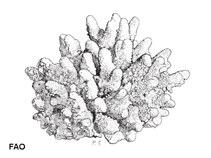Acropora humilis (Dana, 1846)
Finger coralWarning: DOMDocument::load(): SSL operation failed with code 1. OpenSSL Error messages: error:140770FC:SSL routines:SSL23_GET_SERVER_HELLO:unknown protocol in C:\Apache24\htdocs\includes\SpeciesSummary.lib.php on line 1236
Warning: DOMDocument::load(): Failed to enable crypto in C:\Apache24\htdocs\includes\SpeciesSummary.lib.php on line 1236
Warning: DOMDocument::load(https://sealifebase.nrm.se/webservice/AquaMaps/getAMap.php?genus=Acropora&species=humilis): failed to open stream: operation failed in C:\Apache24\htdocs\includes\SpeciesSummary.lib.php on line 1236
Warning: DOMDocument::load(): I/O warning : failed to load external entity "https://sealifebase.nrm.se/webservice/AquaMaps/getAMap.php?genus=Acropora&species=humilis" in C:\Apache24\htdocs\includes\SpeciesSummary.lib.php on line 1236
Classification / Names Common names | Synonyms | CoL | ITIS | WoRMS
Anthozoa | Scleractinia | Acroporidae
Environment: milieu / climate zone / depth range / distribution range Ecology
Reef-associated; depth range 3 - 10 m (Ref. 98622). Tropical; 30°N - 34°S, 27°E - 135°W (Ref. 846)
Distribution Countries | FAO areas | Ecosystems | Occurrences | Introductions
Indo-Pacific. Tropical to subtropical.
Length at first maturity / Size / Weight / Age
Maturity: Lm ? range ? - ? cm Max length : 19.9 cm BRL male/unsexed; (Ref. 269); common length : 2.5 cm BRW male/unsexed; (Ref. 269)
Short description Morphology
A corymbose growth form distinguishes this spcies. Individual branches form fat fingers, 0.1-0.25 cm in diameter and less than 20 cm in length, with little secondary branching. Due to solid construction, these species is found on exposed reefs throughout its range in shallow to intermediate depths (Ref. 269).
Can be found in shallow waters (Ref. 122680). Found on exposed reefs throughout its range in shallow to intermediate depths (Ref. 269) on reef tops, upper slopes and submerged reefs (Ref. 86439). Also on reef flats (Ref. 98471).
Life cycle and mating behavior Maturity | Reproduction | Spawning | Eggs | Fecundity | Larvae
Hermaphroditic (Refs. 113708, 113712). Mature gametes are shed into the coelenteron and spawned through the mouth. Life cycle: The zygote develops into a planktonic planula larva. Metamorphosis begins with early morphogenesis of tentacles, septa and pharynx before larval settlement on the aboral end (Ref. 833).
Main reference
References | Coordinator | Collaborators
Wallace, C.C. 1999. (Ref. 86439)
IUCN Red List Status (Ref. 130435)
Near Threatened (NT) ; Date assessed: 03 January 2008
CITES status (Ref. 108899)
Appendix II: International trade monitored
CMS (Ref. 116361)
Not Evaluated
Threat to humans
Human uses
| FishSource |
Tools
More information
Internet sources
BHL | BOLD Systems | CISTI | DiscoverLife | FAO(Publication : search) | Fishipedia | GenBank (genome, nucleotide) | GloBI | Gomexsi | Google Books | Google Scholar | Google | PubMed | Hexacorallians of the World | Tree of Life | Wikipedia (Go, Search) | Zoological Record
Estimates based on models
Preferred temperature
(Ref. 115969): 24.9 - 29.3, mean 28.4 (based on 3133 cells).
Price category
(Ref. 80766):
Unknown.



